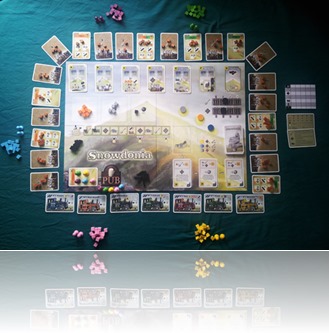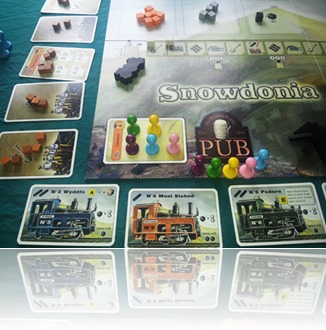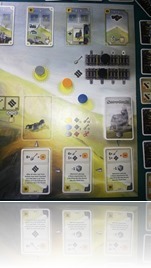![pic1430858_md[1] pic1430858_md[1]](https://www.gmsmagazine.com/wp-content/uploads/pic1430858_md11.jpg) By Michael “Maverick” Chamberlain
By Michael “Maverick” Chamberlain
Snowdonia, released last year, takes as its setting and theme the endeavours of the Snowdon Mountain Tramroad and Hotels Company Limited (mouthful and a half) in the final years of the nineteenth century to build a railroad from Llanberis to the top of Mount Snowdon. Snowdonia is a worker placement game of, to my mind “middle-weight”play and despite having played a fair few train games this one stands out as something different.
The box art is one that speaks to the Englishman in me. Industrialisation is a clear theme and the style reminds me more than a little of Lowry. This hint becomes a certainty once you open the box and start sorting the components. Any box with that many wooden cubes is almost certainly a euro and the art style from the cover of the box carries on through all of the cards (take this a warning if you will but if you love the cover art it’s all good). The wooden components to this game are all nicely finished and easily distinguishable which is much needed as there are so many different types of resources and markers. This even includes one of the most over the top and yet beautiful starting player marker (which owning it became almost a win condition itself during one of the games). The cards that come with the game are all a nice weight and finish all are very clear with the information that is needed for play and visible even from across a table. The board is spaciously laid out. I have played other games with this much unused space on them and I have felt it was wasteful, but in this game it does feel right and allows the theme of the game to have a better position on centre stage. If it had it been produced on a smaller board I am convinced it would have led to a poorer game (more on that later). The final components that come in the box are a very well written set of rules, a cloth resource bag and the blessing that is a pad of score sheets.
Set up for this game is dependent on the number of players with the main set up being the laying out of the cards that represent the tract and station on route to the top of Snowdon from Llanberis. These get laid out around the board (this is what makes such perfect sense of the size of the board) with the station cards telling you how many track cards to be placed between it and the next station (helpfully numbered to ensure you get them in the correct order) and rubble is placed on the relevant spaces as indicated by the clear icons. The Stockyards and resource bag is also set up with a specific number of iron, stone and coal cubes (depending on the number of players) also all of the five white event cubes are added to the resource  bag. Each player will take their eighty ownership cubes which will be used to track who has built what during play. Players will also take their 4 pawns; one of these goes onto the first station as a surveyor, two are your pool of availed workers and the last one… where is he? In the pub! (It’s hard being a pawn some days). Another major aspect of the board is the weather tracker (its England so of course the weather is going to be a problem). The three weather types are: Rain – which slows down clearing rubble and laying track, Sun – which speeds up the above and fog – which stops them entirely for players. Above the spaces for the cards on the board are three sun shaped spaces for the weather markers. At the start of each turn there will be three of the thirty contract cards available and on the back of each of the contract cards the weather is depicted. The corresponding coloured markers are placed above the cards so players can see what the weather will be for the next 3 days (weather can change if players take a contract card as one of their actions). After that the train cards are laid out for later in the game and the game markers for the work rates (clearing rubble and laying track).
bag. Each player will take their eighty ownership cubes which will be used to track who has built what during play. Players will also take their 4 pawns; one of these goes onto the first station as a surveyor, two are your pool of availed workers and the last one… where is he? In the pub! (It’s hard being a pawn some days). Another major aspect of the board is the weather tracker (its England so of course the weather is going to be a problem). The three weather types are: Rain – which slows down clearing rubble and laying track, Sun – which speeds up the above and fog – which stops them entirely for players. Above the spaces for the cards on the board are three sun shaped spaces for the weather markers. At the start of each turn there will be three of the thirty contract cards available and on the back of each of the contract cards the weather is depicted. The corresponding coloured markers are placed above the cards so players can see what the weather will be for the next 3 days (weather can change if players take a contract card as one of their actions). After that the train cards are laid out for later in the game and the game markers for the work rates (clearing rubble and laying track).
On each turn of the game players will take turns to place their workers in the available work spaces on the board. These actions will be resolved in the order they occur on the board (A-G) and after that the board will be reset for the next round of play. On each of the actions there are a number of spaces so one player taking an action doesn’t mean that others can’t, but space is  still limited.
still limited.
First amongst the actions (A) is the Stockyard which allows you to take resource cubes from the stockyard on the board. Action B is Excavation, this allows you to remove rubble from the next unexcavated track card or a station space equal to the current work rate (if you remove the last rubble cube from a space on a station card you place a player marker of your colour on that space). Action C is the Works action. This allows you to convert three iron cubes into a steel bar or two rubble cubes into one stone cube. Actions D and E are Build actions allowing you to lay track equal to the current work rate (D) or to build station elements (E), as with clearing rubble, players mark the elements they have built for scoring. After the “Trains may now be bought” event this action may also be used to purchase trains. The penultimate action (F) available is the Site office and this is how you acquire the contract cards from the face up pool of cards on the board. Contracts have two aspects to them (aside from the weather on the reverse) one, is an in game effect and the other is for end of game scoring. The in game effects can be used once per game and are written out in full and even has the letter corresponding to the action space it associated with. The end of game scoring icons are very simple and well matched offering you bonus points for completing a set number of elements, such as laid track or cleared rubble. The final action (G) available is to move your surveyor onto the next station this will gain more points at the end of the game.
After each player has resolved all of their actions the board is restocked with cubes from the supply bag and contracts from the deck. If, when drawing resources from the bag a white event cube is pulled then it gets placed on the event track to be resolved. The events are the clock in this game with a good number of these events finishing excavation, laying track or completing stations. There are however, two events that are not linked to building but to trains. Trains only become available to claim after the second event cube. Each train has a unique effect, one allows you to excavate faster while another is worth a fairly heft nine points at the end of the game. The one thing all of the trains have in common is that they allow you to pay a coal to allow you to use your third worker from the pub for one turn (not sure how this works thematically, perhaps it’s a train spotters pub and it is the only way to get them out?) These, needless to say can be very powerful and the extra workers are certainly a boon. Play continues until the final piece of track is built either by the players or by the events forcing it to happen.
 I am cautious of coming across lukewarm when summing up this game and this is something I really want to avoid, as in my mind this is a very well balanced and enjoyably paced euro game. The theme will either grab you or it won’t, there is no doubt in my mind about that. The game is beautifully built around it and aside from getting your extra worker which is slightly disconnected, everything makes sense. I really enjoyed the fact that in this worker placement game there isn’t the usual crush for players trying to take the gain ever more workers, which can prove so decisive. Snowdonia has done away with this which is refreshing and makes every action feel that much more precious without it crippling players with analysis paralysis. The weather element is really different and feels well integrated into the game. The randomising factor of the weather and the events being drawn from the bag adds diversity to this game which keeps it fresh. If you enjoy a well balanced reasonably paced euro I would recommend giving Snowdonia a chance and is certainly one I would gladly play again from time to time. Mav.
I am cautious of coming across lukewarm when summing up this game and this is something I really want to avoid, as in my mind this is a very well balanced and enjoyably paced euro game. The theme will either grab you or it won’t, there is no doubt in my mind about that. The game is beautifully built around it and aside from getting your extra worker which is slightly disconnected, everything makes sense. I really enjoyed the fact that in this worker placement game there isn’t the usual crush for players trying to take the gain ever more workers, which can prove so decisive. Snowdonia has done away with this which is refreshing and makes every action feel that much more precious without it crippling players with analysis paralysis. The weather element is really different and feels well integrated into the game. The randomising factor of the weather and the events being drawn from the bag adds diversity to this game which keeps it fresh. If you enjoy a well balanced reasonably paced euro I would recommend giving Snowdonia a chance and is certainly one I would gladly play again from time to time. Mav.

One Response
I’m always willing to play a game that involves a Pub. Speaking as a Quarter-Welshman, I feel that I owe it to my heritage to give this game a go.